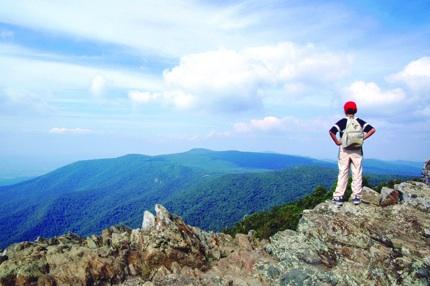When the federal government conceived the idea of a national park close to the nation’s capital and accessible to millions, it didn’t have to look far for the ideal setting. Just 75 miles from Washington, D.C., the shimmering blue rill of Shenandoah is the first line of undulating summits on a drive west across Virginia’s piedmont. The ridge separates the Piedmont from the Shenandoah Valley—and views of both are not to be missed.
In the decade between the authorization and establishment of Shenandoah National Park, President and Mrs. Hoover constructed their “Summer White House” in these hills, the Civilian Conservation Corps (CCC) began building Skyline Drive and over 450 families were relocated from the Blue Ridge so that the state of Virginia could acquire the land it would ultimately donate to the federal government.
Today, this 200,000-acre ribbon of mountains, valleys, and cascading streams is a favorite destination for over a million visitors every year. Skyline Drive remains an iconic feature of Shenandoah, offering stunning views from 75 overlooks along its 105-mile path. Many of the stone wallslining Skyline Drive were hand-built by CCC boys, and infuse a sense of nostalgia throughout the park. Those who choose to leave their cars and explore Shenandoah are in for wonderful treats. Here ramble 500 miles of hiking trails, including 101 miles of the Appalachian National Scenic Trail.

The hike up Old Rag is a Shenandoah classic. NPS photo.
Favorite hikes include Old Rag, an eastern outlier, and the 8-mile, cascade-laced loop of Cedar Run and White Oak Canyon.
The park has over a dozen easily accessible waterfalls and an incredible array of plant and animal life—some of which are found nowhere else on the planet. Forty percent of Shenandoah’s land is federally designated wilderness.
Shenandoah is also a keeper of our nation’s history and harbors numerous structures listed on the National Historic Register, including the Hoovers’ Rapidan Camp and remnants of Skyland Resort, an elegant yet rustic mountain retreat that operated in the late 19th/early 20th century.

Pay a visit to Camp Hoover, aka Camp Rapidan. Photo by David and Kay Scott.
Shenandoah’s scenery and iconic historical features make it one of the nation’s classic and most beloved national parks. How should you lay out your strategy for visiting this park? Let the Shenandoah National Park Trust help you with some insider tips:
Rapidan Camp. The cabins of this secluded spot are the restored summer fishing retreat of President Herbert Hoover and his wife Lou Henry and a long list of important guests. Informative signs interpret the camp. There’s an exhibit in the Prime Minister’s cabin and the President’s House has been restored and refurnished. Check in at the Byrd Visitor for directions and to know when the exhibits are open and programs underway.
Hawksbill Mountain. This highest peak in the park (4,049 feet) offers spectacular views from rocky cliffs and a stone observation platform.

Spend a night or two out along the Appalachian Trail. Kurt Repanshek photo.
The Shenandoah Valley to the west and the park’s most distinctive summit, Old Rag and the foothills to the east, create one of Shenandoah’s most impressive views. A stone shelter (no camping) sits on the peak.
Old Rag. No one can claim Old Rag is a best-kept-secret. It’s very popular, so real care should be taken to come midweek and off-season. The reward for those who do will be a big loop hike that takes in the mountain’s rocky ridge trail, probably Shenandoah’s most rugged ramble. This is the park’s classic climb.


 Support Essential Coverage of Essential Places
Support Essential Coverage of Essential Places







Comments
Another wonderful piece on Shenandoah. Rapidan Camp is a treat!